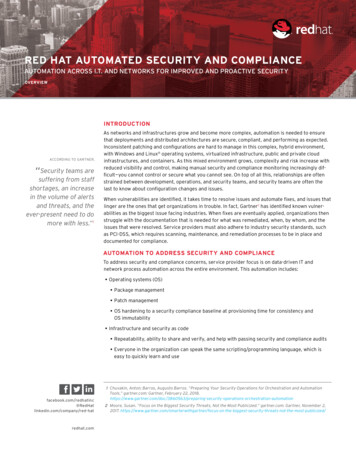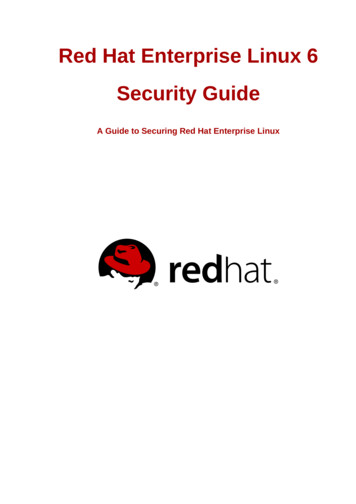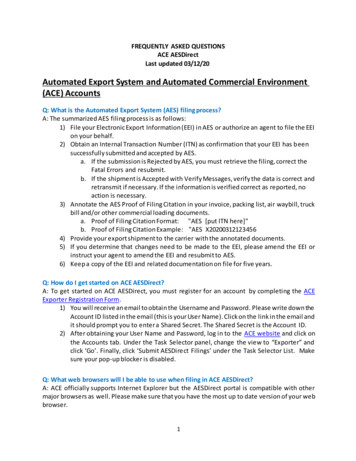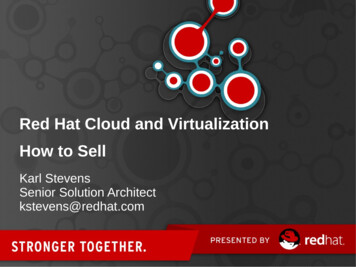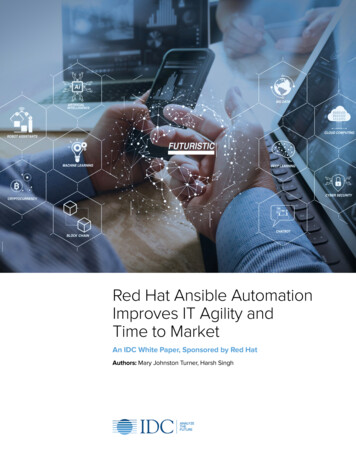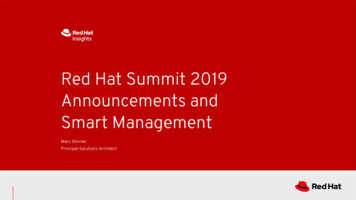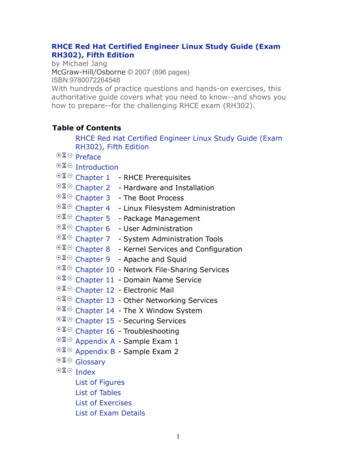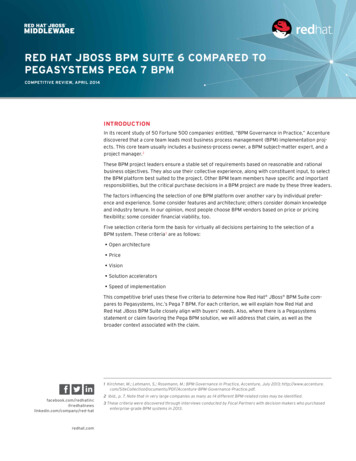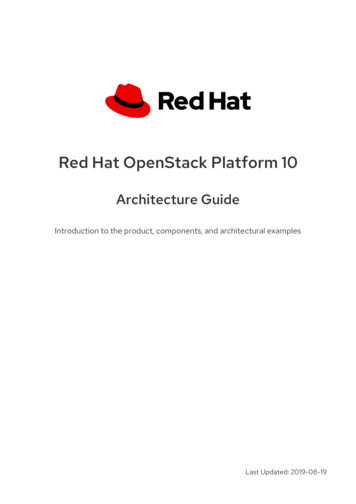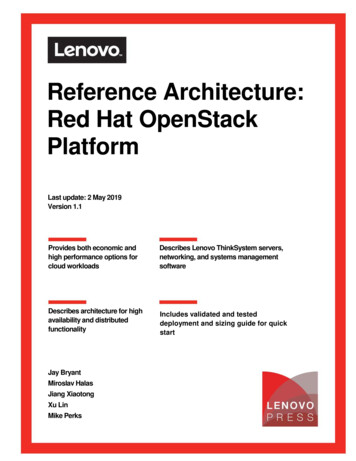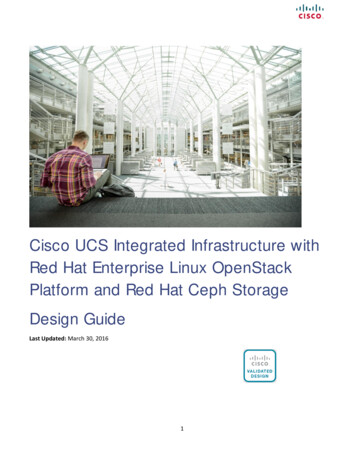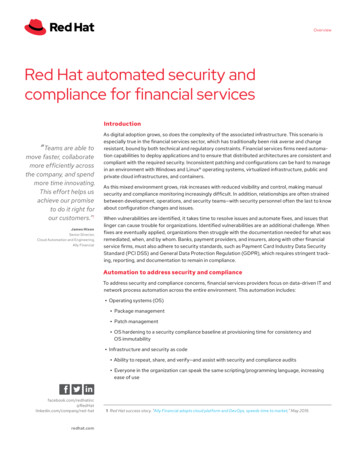
Transcription
OverviewRed Hat automated security andcompliance for financial servicesIntroduction“ Teams are able tomove faster, collaboratemore efficiently acrossthe company, and spendmore time innovating.This effort helps usachieve our promiseto do it right forour customers.” 1James HixonSenior Director,Cloud Automation and Engineering,Ally FinancialAs digital adoption grows, so does the complexity of the associated infrastructure. This scenario isespecially true in the financial services sector, which has traditionally been risk averse and changeresistant, bound by both technical and regulatory constraints. Financial services firms need automation capabilities to deploy applications and to ensure that distributed architectures are consistent andcompliant with the required security. Inconsistent patching and configurations can be hard to managein an environment with Windows and Linux operating systems, virtualized infrastructure, public andprivate cloud infrastructures, and containers.As this mixed environment grows, risk increases with reduced visibility and control, making manualsecurity and compliance monitoring increasingly difficult. In addition, relationships are often strainedbetween development, operations, and security teams—with security personnel often the last to knowabout configuration changes and issues.When vulnerabilities are identified, it takes time to resolve issues and automate fixes, and issues thatlinger can cause trouble for organizations. Identified vulnerabilities are an additional challenge. Whenfixes are eventually applied, organizations then struggle with the documentation needed for what wasremediated, when, and by whom. Banks, payment providers, and insurers, along with other financialservice firms, must also adhere to security standards, such as Payment Card Industry Data SecurityStandard (PCI DSS) and General Data Protection Regulation (GDPR), which requires stringent tracking, reporting, and documentation to remain in compliance.Automation to address security and complianceTo address security and compliance concerns, financial services providers focus on data-driven IT andnetwork process automation across the entire environment. This automation includes: Operating systems (OS) Package management Patch management OS hardening to a security compliance baseline at provisioning time for consistency andOS immutability Infrastructure and security as code Ability to repeat, share, and verify—and assist with security and compliance audits Everyone in the organization can speak the same scripting/programming language, increasingease of ny/red-hatredhat.com1 Red Hat success story. “Ally Financial adopts cloud platform and DevOps, speeds time to market,” May 2019.
System provisioning Integration with IT service management (ITSM) Storage provisioning Workflows Simplified services management Continuous security and monitoring with Day 2 security operations Patch management Vulnerability identification and management (e.g., health checks) Proactive governance of security, control, and compliance policies Remediation: fix generation and automationSecurity and compliance automation challengesManually checking systems for security and compliance is problematic for many reasons: Time-consuming and tedious Prone to human error Improper actions and simple configuration changes lack audit trail information Not repeatable, shareable, or verifiable Difficult to pass audits due to incomplete and inconsistent changelog information Ineffective or nonexistent communication between operations and security teamsFinancial products and services firms must determine where manual tasks are performed, and theirfrequency, to determine an automation strategy. They should focus on flexible automation technologies to accommodate future requirement changes. Selecting the right automation technologies is keyfor rapid implementation and expansion across network devices and services.Intelligent security automation with Red HatRed Hat technologies offer an end-to-end software stack to support your automation strategy—from a security-hardened operating system and automation software, to dozens of vendor integrations (AWS, Cisco, Juniper, VMware, etc.), encompassing both IT and networking automation needs.Having an entire stack of Red Hat technologies is not required, but the power of security and compliance automation is amplified when Red Hat products are combined. In the case of security andcompliance automation, the combination of Red Hat Enterprise Linux, Red Hat Ansible AutomationPlatform, Red Hat Satellite, and Red Hat Insights is particularly powerful.redhat.comOverview Red Hat automated security and compliance for financial services2
Red Hat Platform ManagementLife-cycled content management, automated remediation, and prescriptive analyticsContentAutomationAnalyticsBuild a trusted and more secureRed Hat environmentCentralized automationGovernanceProactive automatedResolutions Manage content and patches Provision and configure at scale Define and implement your SOE Centralized control Team and user delegation Audit trail Continuous insights Verified knowledge Proactive resolutionPhysicalVirtualPrivate cloudPublic cloudFigure 1. Red Hat technologies combined for enhanced security and compliance.These Red Hat technologies work together for additional security and compliance benefits:Red Hat Enterprise LinuxRed Hat Enterprise Linux provides security technologies to combat vulnerabilities, protect data, andmeet regulatory compliance. You can automate regulatory compliance and security configurationremediation across systems and within containers with OpenSCAP, Red Hat’s National Institute ofStandards and Technology (NIST)-certified scanner that checks and remediates against vulnerabilities and configuration security baselines, including: PCI DSS. Defense Information Systems Agency (DISA) Security Technical Implementation Guide (STIG). Criminal Justice Information Services (CJIS) security policy. Commercial cloud services (C2S). Health Insurance Portability and Accountability Act (HIPAA). NIST 800-171. Operating System Protection Profile (OSPP) v4.2. Red Hat Corporate Profile for Certified Cloud Providers.To better meet the varied security needs of hybrid computing, Red Hat Enterprise Linux providesenhanced software security automation to mitigate risk through integration of OpenSCAP withRed Hat Ansible Automation Platform. This integration supports the application of pregeneratedRed Hat and supported Ansible Playbooks to remediate systems for compliance with security baselines, the creation of new Ansible Playbooks from a specific security profile, and the creation ofAnsible Playbooks directly from OpenSCAP scans. These can be used to implement remediationsmore rapidly and consistently across a hybrid IT environment.redhat.comOverview Red Hat automated security and compliance for financial services3
Red Hat Enterprise Linux system roles also help with automated security, utilizing a collection ofAnsible roles and modules that provide a stable and consistent configuration interface to remotelymanage Red Hat Enterprise Linux 6.10 and later versions. For example, the Security-Enhanced Linux(SELinux) system role can be used to correctly and consistently configure SELinux across Red HatEnterprise Linux systems.By automating common management tasks, fewer users require direct superuser access to hosts,reducing attack surface area. Using SELinux, automated management tasks can be assigned privileges specific to that task, guarding against privilege escalation bugs.Red Hat Ansible Automation PlatformRed Hat Ansible Automation Platform, which includes Red Hat Ansible Tower, is simple, powerful,agentless IT automation technology that provides a common automation platform across the organization, providing the following security and compliance benefits: Traceability and repeatability for compliance Drastically reduced time spent on repetitive tasks Reduced risk of downtime through a consistent infrastructure management approach Minimized risk of systematic errors through automated analysis, detection, and resolution Accelerated time to revenue by bringing technology into service faster Reduced risk of human error Accelerated IT processes (often from days to minutes) Consistent configuration and management across a multivendor environment Automated deployment, configuration, and configuration life-cycle management, including policyrollout and updating systems and firewalls across the entire network Rapid replication of field problems using configuration information in service catalogs Ability to embed Ansible Automation Platform into existing security tools and processes using representational state transfer application programming interface (RESTful API) Highly scalable automation solution covering access control, credentials vault, job and workflowscheduling, source control integration, and auditing with graphical inventory management, simplifying representation of all components and providing visibility into all automation activityAnsible Automation Platform includes modules and roles specifically created for integration withsecurity vendors and security solutions, for example, Splunk (SIEM), Snort (intrusion detection andprevention), and Checkpoint (enterprise firewall).Red Hat SatelliteRed Hat Satellite provides IT with information about Red Hat systems in the environment, includingidentifying systems that are out of date and with known vulnerabilities. Organizations use Satellite forsubscription and content management, provisioning security-compliant hosts, configuration management, and patch management. Ansible Automation Platform works with Satellite to automaticallydeploy and manage software configurations for end-to-end, automated management and control ofsystems and applications throughout their life cycle, helping maintain security, compliance, and anaudit trail.redhat.comOverview Red Hat automated security and compliance for financial services4
Red Hat Satellite: Defines and enforces a standard operating environment (SOE). Uses Ansible Automation Platform to deploy Red Hat Enterprise Linux system roles and installRed Hat Insights for the SOE. Identifies drift from the SOE and uses Ansible Automation Platform to remediate drift issues. Identifies security, performance, stability, and availability risks through Insights, which can thendynamically generate Ansible Playbooks for direct execution from Satellite for risk remediation. Systems provisioned via Satellite can perform callbacks to Ansible Tower for post-provisioningplaybook execution. Use of Ansible Automation Platform to import and use Red Hat Enterprise Linux system roles. Via the dynamic inventory, Ansible Tower uses Satellite as a dynamic inventory source. Insights can be deployed using Ansible Automation Platform from within Satellite.Red Hat InsightsRed Hat Insights is included with Red Hat Satellite and can also function individually as a Red HatEnterprise Linux add-on. Findings from Insights provide actionable predictive analytics and whenintegrated with Ansible Tower, Insights can be configured to automatically generate playbooks andperform remediation. Ansible Tower uses the Insights API to support jobs for site-wide remediation.Insights detection and remediation capabilities can be integrated into external systems or scripts,giving operations teams the ability to scale guided remediation out to the entire enterprise.Ansible Tower can be configured to connect to the Insights API to retrieve information from it. Forexample, Ansible Tower can pull the Ansible Playbooks used in the Customer Portal version ofRed Hat Insights, and these playbooks can be launched directly from Ansible Tower for automatedremediation of issues.Infrastructureas codeCentralizedmanagement,control, andvisibility of hybridinfrastructureProvision securitycompliant andhardened hostsContinuous securityand monitoringConsistent andautomated patchingand configurationmanagementAutomated securityscanning andremediationsSecurityas codeCommon management and automation3rd-party integrationsSecurity starts at the foundation withFigure 2. Automated security and compliance with Red Hat.redhat.comOverview Red Hat automated security and compliance for financial services5
Use case: Automated patch managementWorking together, Red Hat Satellite, Red Hat Insights, and Red Hat Ansible Automation Platformseamlessly detect risks to Red Hat Satellite-managed hosts and fix many of these discovered issuesusing Red Hat Ansible Automation Platform Playbooks. You can create a repeatable remediation plan,act upon that plan, and provide report information to auditors. Insights can be configured to controlthe type of information that is sent to Satellite, allowing you to see the transmitted data andmanage it.1.Use Insights to identify systems that require patching.2.Create an Insights plan for the playbooks you want to run and the systems on which to run them.3.Schedule the execution of the Insights plan or run it manually.4.Act on the information provided by the Insights plan. Insights learns and gets smarter with everyadditional piece of intelligence and data. It can automatically discover relevant insights, proactively recommend tailored next actions, and even automate tasks.5.Provide consolidated audit trail information produced by the execution of the Insights plan, whichincludes who ran the plan, the start and end times, and task-level execution.SummaryAs financial networks evolve toward programmability, and applications add complexity, automation iscritical for managing the IT and network environment. The Red Hat automation and compliance solution addresses financial service provider concerns with end-to-end automation for IT and networks.Whether enabling Red Hat Satellite to provision and configure security-compliant systems, usingRed Hat Insights data to proactively resolve security issues, or using simple automation to deploy,manage, and upgrade your cloud, Red Hat Ansible Automation Platform provides the common automation language and operational layer with the exposed APIs needed for end-to-end automation.This approach is especially applicable across organizations with device-specific and app-specificneeds for holistic security. Red Hat Ansible Automation Platform provides automation for the entireRed Hat Enterprise Linux environment, including discovering environment information, adhering toorganizational policies, and enacting configuration changes based on that policy.All Red Hat products are vendor-agnostic, and can support your IT environment without replacingcritical legacy applications and processes, providing integration and orchestration of security tasksand processes across devices, platforms, and vendors. Internal resources can focus on innovation,while Red Hat supports your critical security automation and simplifies your services management.Next steps To initiate or expand security and compliance automation, a Red Hat Discovery Session analyzesyour environment for automation opportunities. Red Hat Services also offers a more comprehensive offering for automating security and reliability workflows, combining Red Hat Insights, RedHat Satellite, and Red Hat Ansible Tower to identify existing gaps or potentially problematic configurations identified by Insights. The offering provides a scalable framework on which to use andcustomize Insights-provided playbooks, and also use and deploy customer playbooks, to remediatevulnerabilities and provide an audit trail across the IT environment.redhat.comOverview Red Hat automated security and compliance for financial services6
Overview Attend the security and compliance for financial institutions webinar to learn more about howRed Hat security management technology can help reduce infrastructure risk in your financialorganization.Learn more about Red Hat solutionsRed Hat Satellite, Red Hat Insights, and Red Hat Ansible Automation Platform provide additional security management and control across the Red Hat portfolio, for example, Red Hat OpenShift clients.Other Red Hat technologies provide functionality to specifically address key security and complianceconcerns. Red Hat understands that end-to-end security, compliance, and auditing orchestration isneeded in today’s constantly changing environment and provides the platforms and tools needed formanagement and control.For questions or additional information, contact your Red Hat representative or read more aboutfinancial services automation.About Red Hat Red Hat is the world’s leading provider of enterprise open source software solutions, using a community-poweredapproach to deliver reliable and high-performing Linux, hybrid cloud, container, and Kubernetes technologies.Red Hat helps customers integrate new and existing IT applications, develop cloud-native applications, standardize onour industry-leading operating system, and automate, secure, and manage complex environments. Award-winningsupport, training, and consulting services make Red Hat a trusted adviser to the Fortune 500. As a strategic partnerto cloud providers, system integrators, application vendors, customers, and open source communities, Red Hat canhelp organizations prepare for the digital ompany/red-hatredhat.com#F23392 0420North America1 888 REDHAT1www.redhat.comEurope, Middle East,and Africa00800 7334 2835europe@redhat.comAsia Pacific 65 6490 4200apac@redhat.comLatin America 54 11 4329 7300info-latam@redhat.comCopyright 2020 Red Hat, Inc. Red Hat, the Red Hat logo, Ansible, and OpenShift are trademarks or registered trademarks of Red Hat, Inc.or its subsidiaries in the United States and other countries. Linux is the registered trademark of Linus Torvalds in the U.S. andother countries.
redhat.com Overview Red Hat automated security and compliance for financial services 2 System provisioning Integration with IT service management (ITSM) Storage provisioning Workflows Simplified services management Continuous security and monitoring with Day 2 security operations Patch management Vulnerab
